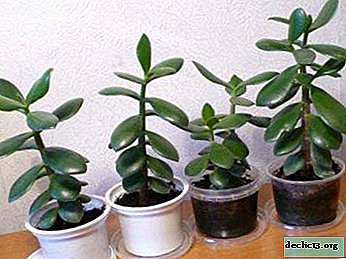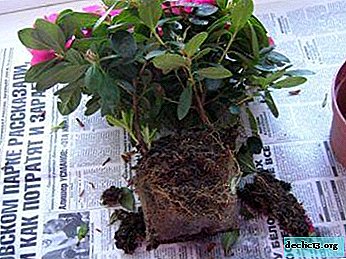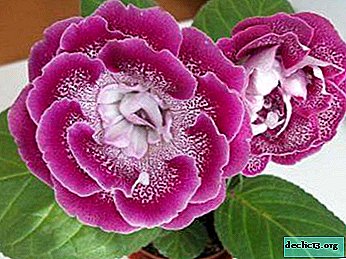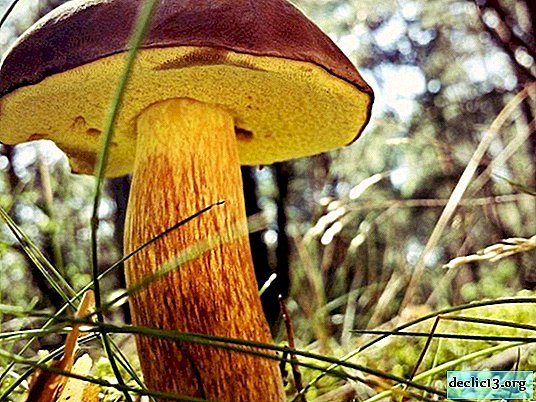Features of growing Wanda's orchid at home: how to make a plant bloom?
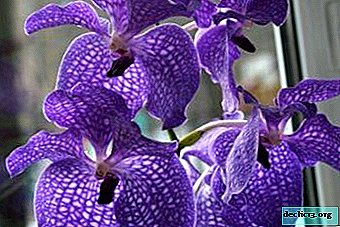
Gradually, completely exotic plants began to appear in our homes, which previously we could only see at exhibitions or in some fashion magazine.
More and more different types of orchids have already been adapted for home maintenance, including the beautiful Vanda - breeders specially bred her short-stemmed hybrid. From the article you will learn how this flower looks, how to properly care for and fight diseases.
Brief definition of the species
Wanda - an unusually beautiful epiphytic plant, belongs to the genus Orchid, is considered the queen of orchids. She has bright large flowers and a whole mop of powerful roots. In nature, grows on trees, can grow on rocks, but not on the ground.
Evergreen orchid Wanda does not have a distinct dormant period, and therefore not so long ago they began to breed this species at home, but he fell in love immediately, because it blooms several times a year, and for a long time, however, it requires care.
Detailed description
 Under natural conditions, Wanda is an impressive species of vineIts size is capable of reaching several meters in length. It grows only upward, its entire trunk is covered with green (sometimes grayish) leathery leaves, arranged in turn one after another. Peduncles are produced from the leaf sinuses, they can simultaneously be 3 or 4, fragrant large flowers bloom on each of them (up to 15 flowers per 1 peduncle).
Under natural conditions, Wanda is an impressive species of vineIts size is capable of reaching several meters in length. It grows only upward, its entire trunk is covered with green (sometimes grayish) leathery leaves, arranged in turn one after another. Peduncles are produced from the leaf sinuses, they can simultaneously be 3 or 4, fragrant large flowers bloom on each of them (up to 15 flowers per 1 peduncle).
Wanda's orchid flowers form a huge brush of various colors - white, orange, yellow, red, blue, colorful, but the most attractive is the exotic blue. At home, of course, the proportions are slightly different: the height of the orchid can reach one meter, the leaves grow up to 20 cm in length, and on peduncles 3-6 flowers can bloom.
REFERENCE: When the flower only blossoms, it has a small size and rather faded color, but then every day it grows in size and the color gains brightness and juiciness. Wanda can bloom with good home care for as long as 3 months, and in nature she now lives in India, Thailand, Indonesia, China.History of occurrence
Wanda in 1795 was officially registered by the Englishman William Jones, he first described this orchid while traveling in Asia. Translated, "Wanda" means "whisper of the wind", by the way, before its leaves were used for medicinal purposes for bronchitis.
What is the difference from others?
In addition to its amazing exotic beauty, Wanda differs from other orchids in the presence of long, powerful, interwoven hanging roots of gray-green color. Their surface is a porous structure and is capable of absorbing moisture not only from grass and tree trunks, but also from the atmosphere.
Subsort plants: description and photo
Check out the photo of Wanda's orchid, see how it can look with proper care at home.
Now there are more than 80 hybrid varieties and varieties of this orchid, Wanda is great for crossbreeding - to get new varieties, flower growers love to work with her. Most suitable for home content of Wanda's sub-grade:
Comb Wanda
She is the owner of blood-red or yellow large flowers with a pronounced aroma.
Great Wanda
Originally from Malta, the orchid is large, the owner of a thick stem and hard long leaves. Flowering usually occurs in summer, lasts a long time, flowers are brownish-yellow in color, their diameter is about 4 - 5 cm.

Blue wanda
The color of its petals speaks for itself, although there may be a shade of lavender, on one peduncle there are up to 15 huge (10 cm diameter) fragrant flowers. By the way flower stalk is also impressive - its length reaches 50 cm.

Tender wanda
This beauty usually blooms in spring, her flowering is very lush - 12 large white flowers with purple dots bloom on one peduncle

Bloom
When and how?
Like many other Vanda orchids, it can bloom all year long; it does not have a distinct dormant period. But it blooms most magnificent in spring and summer (1.5 - 3 months). Wanda's flowers are simply delightful, it is difficult to take their eyes off them, especially since they are collected in a falling bunch, that is, a cascade of large, bright and fragrant flowers is obtained.
Care before
Before flowering, you need to create suitable conditions for the orchid, that is, competently approach the study of the rules of keeping Wanda and strictly follow them: to choose the right place for her, temperature, humidity, lighting, watering regime.
After
It is necessary to remove the peduncle, stop spraying the flower, give less moisture to the roots. In general, it would be ideal to take her to the balcony during this period, the fresh air for the orchid is now like an elixir.
If not blooming
If your orchid Wanda does not want to bloom for a long time, then she doesn’t like something, there may be little light or the temperature difference between day and night can not be maintained, there is only one way out, how to make it bloom - you need to provide Vanda with comfortable conditions and she will thank.
Step-by-step instruction
- Seat selection.
The best place to plant Wanda's orchid, of course, is a greenhouse or mini-greenhouse, but you can also place this exotic orchid on the window in the apartment and provide care, only where there is a lot of light;
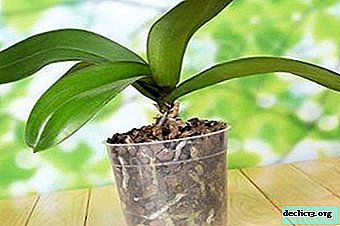 Preparing the soil and pot.
Preparing the soil and pot.If you decide to plant the plant in a substrate, then it should be very light and breathable, it may include: large pine bark, coarse sand, moss, perlite, and charcoal. In general, you can do without a substrate - just hang Vanda in a basket or in a special pot - similar to a sieve because of the large number of holes.
- Temperature.
Enough within 25 degrees, if it is a little higher - it’s not scary, the main thing is that at night it does not fall below 12 degrees and you need to remember that Wanda does not tolerate a draft.
- Humidity.
very high is required: 70 - 90%, therefore, spraying is indispensable, you need to take care of a humidifier - buy it or make it at hand.
- Lighting.
In winter, it is best for Vanda to have a little natural light on the south window, of course, so you need to organize additional lighting, and in the summer you will definitely need to shade it - protect it from sunburn or rearrange it on the western window.
- Watering.
In autumn and winter, you need to water it once a week (if the days are sunny) or once every ten days (on cloudy days), in the summer, about once every 3 to 4 days, watering is done by soaking the roots in the bathroom (20 minutes) or under a warm shower. All water procedures should be carried out only in the morning and the orchid should dry in the bathroom, it should be put in its place without traces of water.
- Top dressing.
Wanda needs a lot of nutrients, so you need to feed her once a week with complex fertilizer (especially for orchids);
- Transfer.
It is best to engage in transplantation in the spring, too often it is not worth disturbing the plant, you can at least once every 2 years. The main thing when transplanting is not to damage the roots, to handle them with extreme care.
Important! The transplantation process itself is classic - we take out the flower from the pot, slightly shake off the old soil and plant a slightly larger volume with a fresh substrate in a new pot.
Next, you can watch a video that tells about the care of the Wanda orchid:
Growing in a glass flask
 Orchid Wanda can be grown at home in a glass flask. - in a transparent flask without water and substrate, but this requires special care. From time to time, it will be necessary to take it out and place it in a basin with dissolved fertilizers (mineral) for two hours, then hang it up so that the glass of water and the roots of Vanda's orchid dry out, and then we return it back.
Orchid Wanda can be grown at home in a glass flask. - in a transparent flask without water and substrate, but this requires special care. From time to time, it will be necessary to take it out and place it in a basin with dissolved fertilizers (mineral) for two hours, then hang it up so that the glass of water and the roots of Vanda's orchid dry out, and then we return it back.
You need to choose the size of the flask so that the roots fit freely inside, and the leaves reliably rest on the edges of the flask. It all looks stylish and beautiful.
In the flask should be placed only the roots of orchids, and leaves and flowers on top!
In a vase
In addition to the glass flask Orchid Wanda can also be placed in a glass vase, and, it is best to choose a vase narrowed below and expanded at the top, resembling the shape of a glass. This form for Wanda will be the most convenient. And the care is exactly the same as when kept in a flask.
How to propagate?
Despite its exotic nature, Vanda can also be tried to propagate at home.
Over time, roots appear in the axils of the leaves of this orchid, you will need to divide the bush - cut off the upper part with the roots. Immediately treat the cutoff area with charcoal, allow it to dry a little and plant in a special substrate for orchids. To take care very carefully, you can water only from the spray gun once a week, and we enter the normal watering regime only when our plant starts growing.
Diseases and Pests
Of course, uninvited guests, such as ticks, thrips, scabies or aphids, may appear on the plant, but, due to the fact that Wanda often has to bathe, pests rarely hit her. But you need to carefully monitor that it is not affected by fungal diseases (again, due to a great love of water).
TIP: The most common disease of Wanda is fusarium, dark spots appear on the plant at the base of the leaves, it will be necessary to treat the orchid with Fundazol. Another problem is bacterial rot, Fitosporin will help here.Prevention of various problems
To prevent diseases, Wanda needs:
- constantly remove yellowed leaves and dead roots;
- not to allow waterlogging - otherwise the leaves may shrink and soften, rot the trunk;
- avoid overheating - the leaves turn yellow.
What can be said in the end - orchids are now incredibly popular and in demand, everyone loves them! Designers constantly use them in floral decorations, flower growers gradually tame the most exotic species and look for new forms, breeders work tirelessly, constantly creating new hybrids. Orchids coolly decorate and color our whole life, and not just our apartments.

 Preparing the soil and pot.
Preparing the soil and pot.
